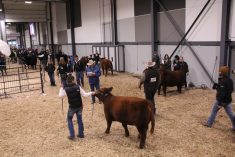Fed cattle
Fed cattle cash prices in recent weeks have moved sharply lower as uncertainty in the market continues to drive live cattle futures lower. Reduced packing plant shifts and temporary closures across North America in recent weeks have pressured the market.
Disruptions to consumers’ lives and livelihoods have shifted consumer spending. Product demand at the retail level is stronger; however, food service sales have plummeted.
The cash price in the fed market as of the second week in April was $143.65/cwt, down $13.91/cwt from the last two weeks and over $20/cwt lower than the same week in 2019. The cash-to-cash basis was -$10/cwt, while the five-year average was -$2.85/cwt.
Read Also

Body condition, nutrition and vaccination for brood cows
One of the remarkable events of the past century related to ranching has been the genetic evolution of brood cows….
Throughout the first quarter of 2020, feedlots have stayed current in their marketings. Steer slaughter to the start of April was 10 per cent higher than a year ago at 426,068 head. Heifer slaughter was down three per cent at 250,885 head.
Carcass weights in recent weeks have decreased as more calves are being added to the slaughter mix. The mid-April steer carcass weight was 912 lbs. The average for 2020 is 909 lbs. which compares to the average weight for the same weeks in 2019 of 925 lbs.
Through the first quarter of 2020, the number of fed cattle — including cows — exported for slaughter totalled 133,351 head. This was seven per cent more fed cattle than the same three months in 2019.
Deb’s outlook for fed cattle: Economic fallout regarding COVID-19 will influence the fed cattle prices. Reduced kill due to plant closures and cutbacks in North America, shifting consumer demand as well as disposable income will all play a role in the stability of the market. Locally, news from one of Canada’s largest packing plants that shifts are to be cut to accommodate labour requirements is not good news.
Fundamentally, fed slaughter to date has been good and inventory manageable as we move into a seasonally strong beef movement period. However, expect lower prices due to smaller kills, an unstable economy and cautionary consumer spending.
Feeder cattle
New social distancing rules have limited sale barn attendance and cattle movement. An uneasy tone to all classes of cattle have pushed prices lower as the unknowns surrounding the market are proving too risky to speculate against.
Demand for grasser-type cattle should peak this time of year; however, recent weeks have seen the 550-lb. feeder steer average drop nearly $8/cwt (as of mid-April), which is $13.50/cwt under the same week last year. There are fewer shorter-keep cattle on offer seasonally; however, pressure on technical markets and nervousness surrounding summer fed prices is evident as the 850-lb. feeder steer average is $28.46/ cwt lower than the price seen at the start of 2020. The mid-April average, at $160.39/cwt, was down almost $7/cwt from the week before and $22.28/cwt lower than the year-ago average.
Feeder basis was -$7.75/cwt as of mid-April, which was $17.97/cwt wider than the start of April. The five- year average was $11.51/cwt. Feeder exports to the U.S. were down 47 per cent in the first quarter of the year. Only 34,821 head of feeders were exported from January through March.
Deb’s outlook for feeder cattle: Supply chain disruptions and economic concerns pressuring the fed cash and futures market will spill over to the feeder cattle prices in the near term. Extreme uncertainty in the cattle industry and losses at the finishing level are making it difficult for feeders to hold current prices. Barley prices have strengthened slightly in recent weeks, as has the Canadian dollar. Both are negative factors to feeder cattle.
It’s to be hoped the packing plant disruptions are short-lived and live cattle futures rebound to a level that makes available risk management options more favourable. In the near term, price spread between grass-type cattle and shorter-keep, heavier feeders will widen. However, both will likely continue trending downward until some stability returns to the industry.
Non-fed cattle
The cull cattle price remained relatively stable throughout the past month. The increased retail sales supported increased grinding and trim meat movement and kept non-fed beef demand strong.
The second week of April saw reduced kill numbers and pressure started to reach the cull cow market. The average D1,2 cow price the week of April 10 was $87.63/cwt, down just $2.70/cwt from the year-ago price. The 2020 high to date was in early April, when cows traded with an average of $92.80/cwt.
At the time of writing, cow kill was down 10 per cent from the same weeks in 2019. The total up to April 4 was 146,215 head.
Bull price average the second week of April was $113.07/cwt, which was a drop of 3.43/cwt from the previous week. Bull slaughter was three per cent below a year ago at 2,908 head. Exports of slaughter bulls to the end of March were down one per cent to 7,775 head.
Deb’s outlook for non-fed cattle: Over the past several weeks as the cattle industry worked through the uncertainties around COVID-19, the non-fed or cull cattle market has held more stable ground as many of the shifts in consumer behaviour support the trim and grinding meat markets. While consumers will continue spending more time at home — which does support the non-fed market — what is uncertain is how reduced kill hours and supply chain disruptions will play out. A focus on fed cattle kill will limit space for cull cattle and ultimately limit buyers.
One positive note around the cull market is the time of year. Non-fed supply is very limited during the second quarter, which should help support prices. Expect volatility and price pressure.
















